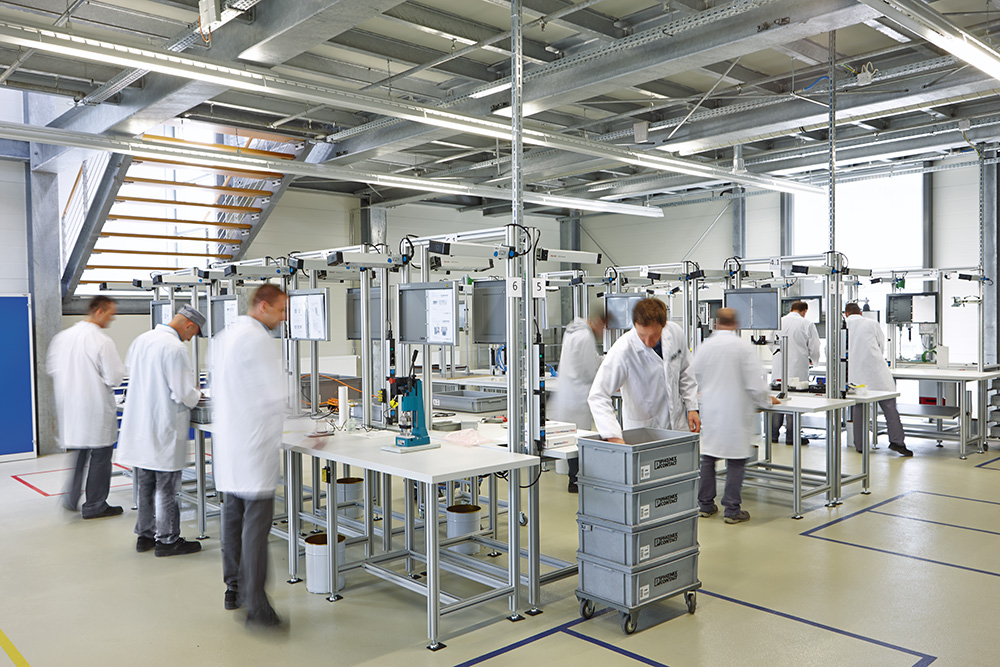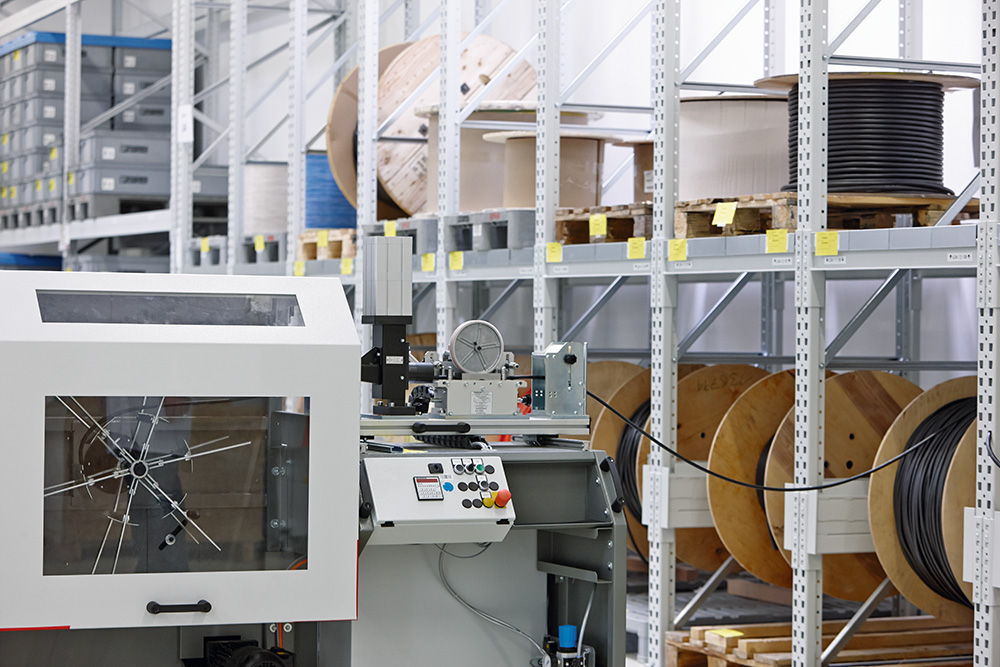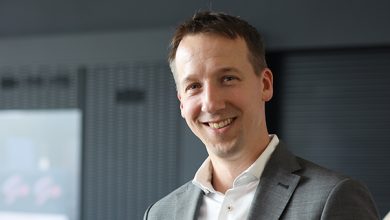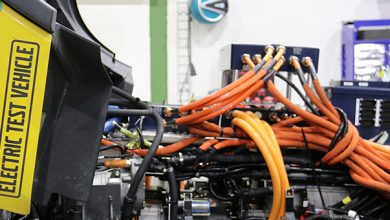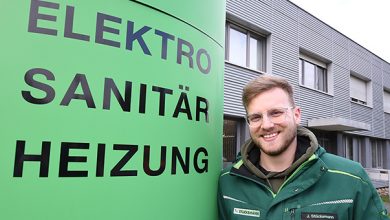Anyone entering the Phoenix Contact E-Mobility production area will immediate note the atmosphere of concentrated activity. Each handle has to fit, and every little component must be set exactly in the right place. There is no room for booming full automation; only for experienced professionals with a love of precision.
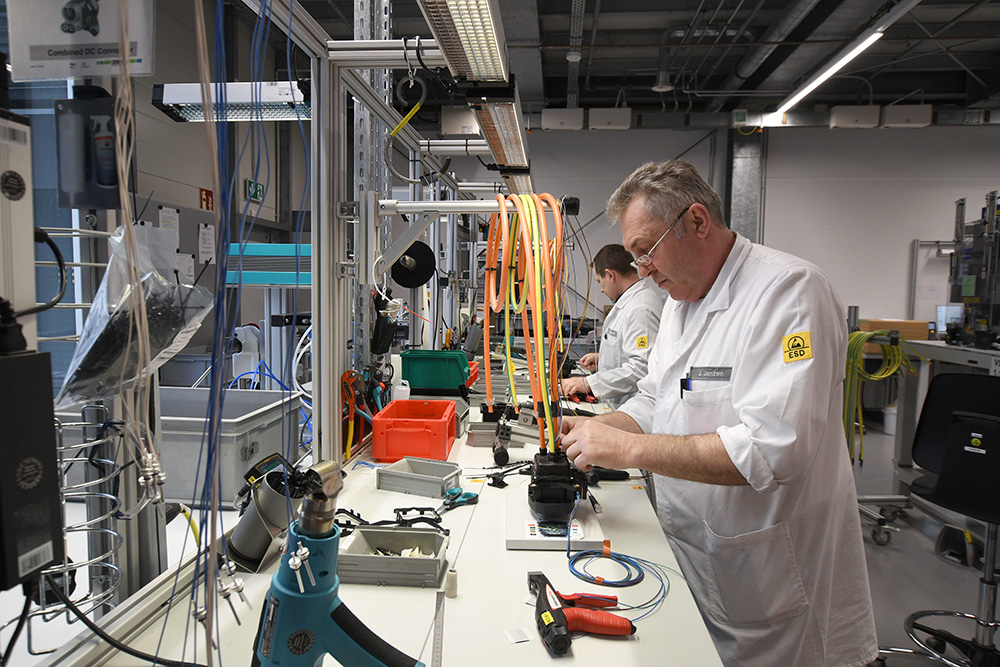
Bodo Finken likes to meet his visitors directly at the door to “his” production facility. Because you can’t just walk in here. Those who work for or supply the automotive industry are very reluctant to show their cards – discretion is key in this industry. But with the Head of Production at your side, this hurdle is quickly overcome.
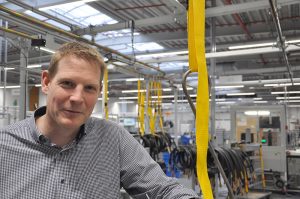
And then there is the fact that it is quite different from a “normal” production facility. While other machine parks rattle and rumble, click and clack, sometimes loudly, rarely quietly, there is a concentrated calm near-silence in Schieder. All around, employees dressed in white coats devote themselves almost devoutly to the assembly of various charging connectors, cables, and vehicle charging sockets – the inlets. Surrounded by working material, mostly at workstations. Every handle fits, every tool is exactly where the hand that’s looking for it expects it to be.
Humble beginnings
“We started out in 2013 as a spin-off with 23 employees from the Business Area DC, that is to say the connector division. A major customer from the automotive industry had asked the Executive Board whether Phoenix Contact could also enter the field of e-mobility. At that time, we had just one large bus charging connector for the Chinese market. But because the number of inquiries for this field were increasing, we established the spin-off on January 1, 2013.”
The number of employees was still very manageable, with 14 people in administration, logistics, and sales, along with nine production experts. The premises in the former furniture factory in Schieder were just as modest. “Here, this room we’re in right now, this was all we had,” says Bodo Finken as he gestures around the room. “The very first connectors were manufactured in Blomberg as pre-series. The colleagues who worked there were also our first employees here in Schieder.”
Today’s pre-series facility looks very similar to the production facility that we started back then. “We, with our nine experts, initially produced batch quantities of one on a total of 12 simple, completely empty assembly tables – one meter wide, eighty centimeters deep, along with a few hand tools and roller containers with parts – depending on the item version or component. A few shelves, plenty of plastic boxes with material – that’s how we started our production logistics system.
We were absolutely delighted whenever a customer ordered a connector. And then we built the connector. And then another one for the next customer. Until they started ordering five of them at a time. I remember how hectic things got the first time a customer ordered 10 connectors. Back then, every employee was able to build each type of connector blindfolded.”
Treacherous exhibits
But this idyllic scene did not last long. A real run on the connectors from Schieder began in the the very beginning. “We were the first to provide solutions for both AC and DC charging for the American, European, and Asian markets. It is not for no reason that the CCS type 2 connector is still known as the Phoenix Contact connector throughout the world.” very first year. This was due to Phoenix Contact offering a broad product portfolio from
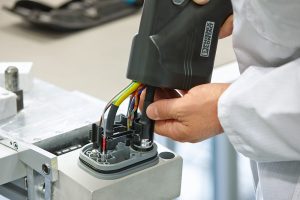
Demand grew exponentially. And it presented the young team, which was actually extremely accomplished, with some quite unusual challenges. “Setting up a production line is part of our daily routine at Phoenix Contact. The big challenge here, though was that there were no templates, no blueprints. Not for the products, not for the tools not for production. After all, who else had already started working in the field of e-mobility back then? Because of this,we first had to find suppliers for tools, machines, and cables. If we hadn’t had Phoenix Contact on our business card, 99 out of 100 suppliers would almost certainly have turned us away without a thought.”
Finken recalls, “Representatives from of the largest suppliers in the field of cable preparation sat right here and insisted on referring to their standard catalog. At the time, they were completely disinterested in the low volumes.” Since then,Phoenix Contact has found e-mobility partners with similar setups, and who are just as engaged in driving electromobility forward.
The next step
After one and a half years, the orders began to increase to hundreds of connectors per order. “We were now at a point where we had arrived in a small-scale-production world, with new demands on the organization of our work. Our charging connectors and charging sockets were high-quality, safe, and tested products, but not yet suitable for true series production.”
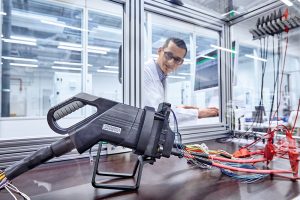
A steep learning curve for the small team. Even today, developers, engineers, and production staff still come together in joint meetings to tweak the system to increase output. “Nobody is better than anyone else in these meetings; we use plain language so that we can achieve improvements together.” An exchange between equals – in Bodo Finken’s opinion, this is a decisive key to today’s success. “As always, we are in a situation where we do classic fundamental research here followed right immediately by building a prototype in a workshop right next door. Speaking with colleagues there is like taking part in a lecture on electrical engineering. It is fascinating when you think that our colleagues are already working on products that will not reach us for several years.”
Developments that also led to fundamental research in production. What began back then with a few sketches on paper has now turned into intelligent worker assistance systems. What seems so obvious today is the result of years of fiddling around. “The workstations are designed mainly by those who use them,” Bodo Finken explains on a short tour of the vastly increased production facility.
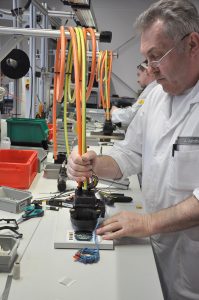
“But cable preparation is and will remain skilled work. Thanks to the close feedback – from development all the way to production at the individual workstations and employees – we have been able to significantly optimize a number of processes and products.”
Team spirit
You need very special employees to do this. “It takes months of training here before a colleague can assemble their first connector. We have extremely experienced professionals from all kinds of trades working in production,from automotive mechatronics technicians to carpenters. Their technical understanding is a part of the production. Sometimes colleagues sit there on their own accord until late in the evening and work on suggestions for improvement that can then help us to move forward.”
Not without pride, Finken explains that “What distinguishes everyone here is the will to improve themselves, their constant desire to learn. A High Power Charging connector consists of more than 150 individual parts. They have to know them like the back of their hand first of all. And in production, there is also a certain amount of physical resilience necessary to handle the heavy cables.
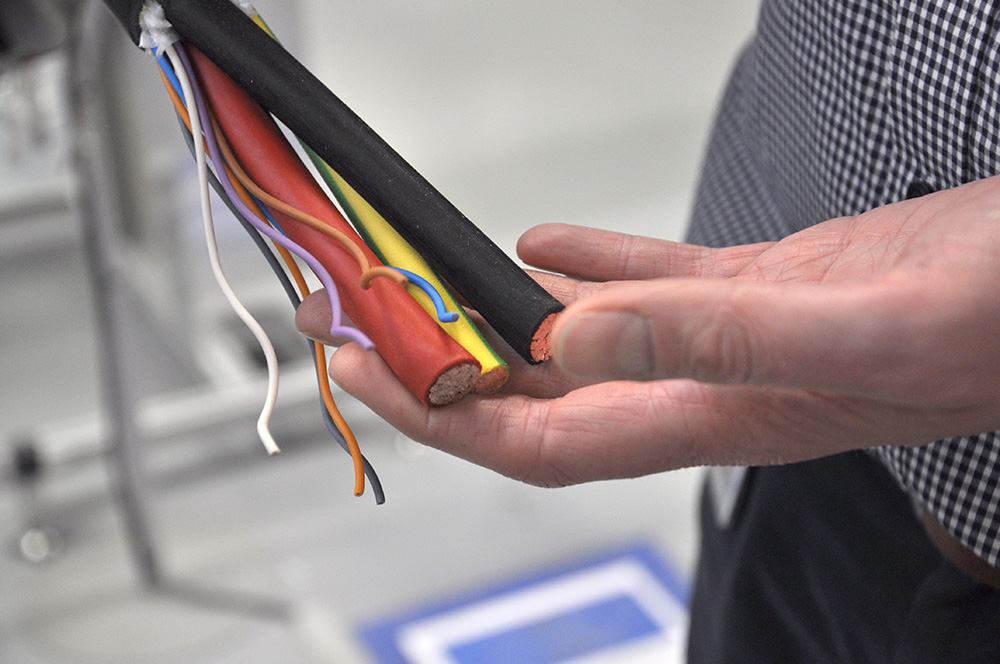
At the time of the spin-off, the decision-makers – the Executive Board – were still concerned about the potential of this new family of items and the whole subject of e-mobility. Our Executive Board has demonstrated entrepreneurial foresight and courage by supporting this subsidiary. Today, we benefit from a mixture of having a strong company behind us and organizational independence – and therefore, technological speed. This distinguishes us from competitors on the market who are many times bigger than us. Short paths, an innovative company structure, well-known suppliers within our own group – who else can print out a sample of a High Power Charging connector overnight?
We have long since ceased to be regarded as the newcomers from the sticks; we are now a supplier and contact point for all of the big players in the industry on an equal footing, both on the automotive side and in the field of charging infrastructure. But cable preparation is, and will remain, and despite all the aids and fixtures, a manufactory production process with a great deal of precise skilled work.”
